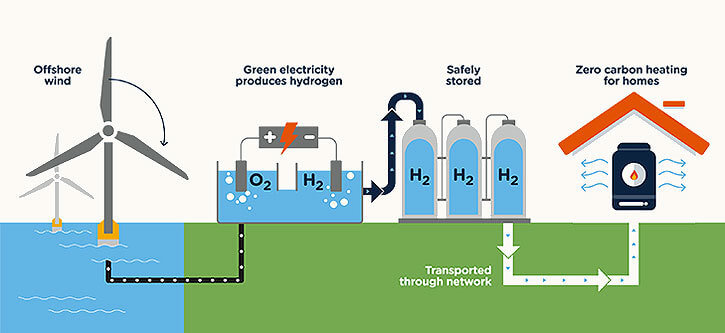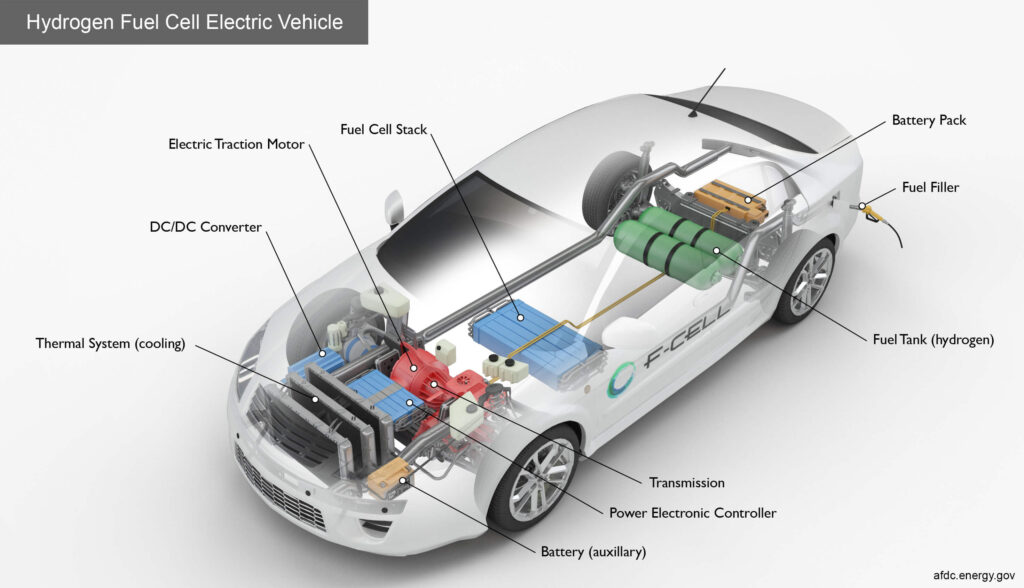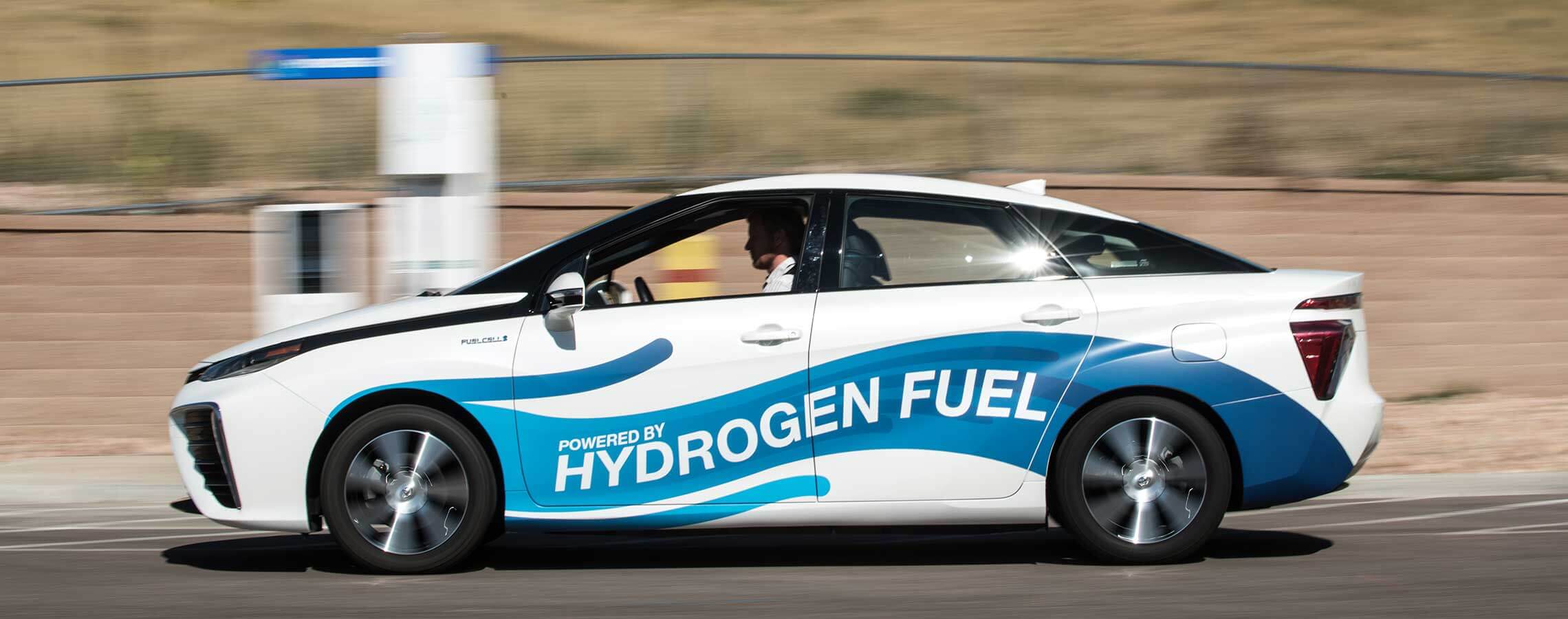Imagine owning a car that has zero emissions — except, this one isn’t by a battery-powered electric vehicle. Feels like an unlikely possibility? It’s really not.
In 2020, India tested its first-ever hydrogen fuel cell prototype vehicle successfully. This fascinating technology splits water into oxygen and hydrogen, which then produces electricity that powers the vehicle. In other words, the car’s engine drives on hydrogen, as opposed to power stored in batteries (as in electric vehicles), or fossil fuels. As for the combustion process, a hydrogen-fuelled car produces only one by-product: water.
As a cleaner fuel that replaces fossil fuels, hydrogen is gaining momentum across the globe. Within this, there has been a special push for “green hydrogen”. The “green” element comes from the fact that for electrolysis — the process that uses electricity to split water into hydrogen and oxygen — renewable energy is used. Last month, the world’s largest green hydrogen plant was inaugurated in Quebec, Canada. Using local hydroelectricity, it produces 8.2 tonnes of green hydrogen per day.

With the 2021 Union Budget, India has officially jumped on the hydrogen bandwagon. During her speech, Finance Minister Nirmala Sitharaman launched a “National Hydrogen Energy Mission” for generating hydrogen from renewable energy, making a statement about India’s commitment to achieving carbon neutrality.
“Hydrogen has been able to attract attention because now we have an alternative for some of the worst problems of our time like fossil fuels, which were proving difficult to solve. But, we must keep in mind that hydrogen is not the solution for everything. Under the Mission, we hope that the government prioritizes the sectors that really need hydrogen, and assess which sectors would work efficiently with other types of energy,” says Thomas Spencer, Fellow at energy think-tank TERI and co-author of the 2020 report, Potential Role of Hydrogen in India.
So then, does the transport sector really need hydrogen cars?
Complementary, not Competitive
Simply speaking, the answer is no. The TERI report explains why. They compared hydrogen fuel cell electric vehicles (FCEV) and a battery electric vehicle (BEV) on the basis of value chain conversion efficiency — a process that exhibits how efficiently a vehicle converts chemical energy from the fuel into mechanical energy. It found that an FCEV would use only 22% of the total input electricity to convert into mechanical energy. The rest gets lost in multiple conversions of electricity into hydrogen and then back to the electricity that eventually powers the vehicle. But for a BEV, the input electricity has to be converted into mechanical energy only once, making it a much more efficient process that uses 73% of the input electricity.

But this does not mean that hydrogen fuel cell vehicles will have nothing to contribute to the transport sector. “For long-distance heavy vehicles, BEVs might not be possible because the size of the batteries would be huge”, says Ulka Kelkar, Director of Climate Program at World Resource Institute, India. “It is here that FCEVs can add value.”
Along the same lines, Kerala has introduced two hydrogen-powered buses which would hit the Ernakulam-Thiruvananthapuram sector by mid-2021. The state plans to introduce another 50 before October this year. The emphasis has been on the long-distance nature of these heavy vehicles; for these buses to compensate for the high investment costs, they would need to operate at least 500 kilometres daily. Decarbonising the transport sector would not benefit from competition, but instead a complementary relationship, between FCEVs and BEVs. One should fill the gaps that the other cannot. Of course, public infrastructure to support FCEVs, like charging points, will need to follow soon.
“The new Green Hydrogen Mission is a wise decision. It may not seem like an immediate priority that needs to be addressed, but it gives us [India] the luxury of time for Research & Development [of the technology], so that when the technology slowly becomes cheaper, the shift to hydrogen for India would be smoother,” says Kelkar.
If not the transport sector, another sector that could gain immensely from hydrogen — while being efficient — are heavy industries.
Heavy industries’ shift to hydrogen
For heavy industries, shifting to electrification through renewable energy is challenging. These industries need high-temperature heat, sometimes over 1000 degrees celsius, which can only be provided by burning fossil fuels. Fossil fuel-free electrification, albeit the best alternative, cannot reach these high heat requirements for industries. “Where electrification is not possible, hydrogen can be a viable non-polluting alternative,” says Kelkar. “Moreover, with the available technology at the moment, transporting and storing hydrogen [which would be needed to support FCEVs] is expensive. It would be cheaper and more efficient to use hydrogen in the same site where it’s produced, which is possible to do for heavy industries.” Hydrogen is also difficult to store: it is dangerously explosive, can embrittle metal, and escape from the tiniest leaks.
Even amongst industries, different levels of prioritization is needed. “In the short-term, pilot projects should begin with the fertilizer sector. This is, after all, one of the most vital industries for the Indian economy, and the country has a high demand for fertilizers. After about five years, more pilots can begin in the steel and cement industries,” Spencer adds.
Currently, the production of ammonia, a commonly used fertilizer, requires the heavy use of natural gas. Hydrogen generated through electrolysis can also produce ammonia, negating the use of natural gas altogether. Similarly, hydrogen also has the potential to replace coking and non-coking coal in cement and steel industries.
While electrolysis is expensive now, experts are optimistic about the future. “The costs of making green hydrogen from electrolysis are falling fast, with $2 per kg production costs likely to be achieved before 2030,” Lord Adair Turner, Co-Chair of TERI’s ETC program had said during the launch of their report in December, 2020.
Ushering hydrogen in
As the Mission nears its on-ground implementation, private players would also need support to shift to hydrogen-powered fuel. “There will need to be policies around tax credits for industries who shift to hydrogen, and to encourage domestic production of electrolysers. These are short-term goals that need to be looked at for a long term shift and usage of hydrogen,” says Spencer.
While hydrogen may seem like the fuel of the hour, Kelkar cautions on hidden environmental costs that cannot be ignored. “The idea behind green hydrogen is to produce it through renewable energy sources, but we are already seeing local conflicts of common lands diverted for solar or wind projects. These are also costs that we need to account for. Also, cobalt, one of the major elements in batteries of EVs, solar panels and wind turbines, is found at the bottom of the sea, which needs to be extracted through deep-sea mining”. This, if not regulated, also has huge ecological impacts on marine life.
Also Read: Dhaval Negandhi on Siting Renewable Energy Projects Sustainably
Green hydrogen is a new, but fast-developing technology. Changes and developments pop up every now and then. With the Hydrogen Mission, India has announced its seriousness about this alternative, now it remains to be seen which sectors will begin piloting this technology, and how the Indian market receives it.
Featured image courtesy National Renewable Energy Laboratory







It is nice
Hiiii